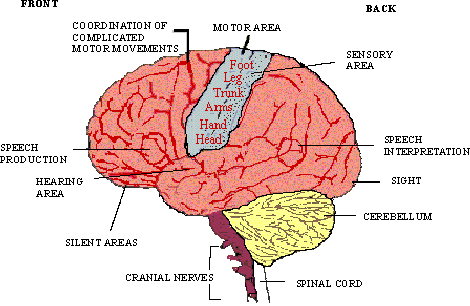c) The hypothalamus forms the floor and
lower part of the brain formed by the thickening of the diencephalon.
Part of the hypothalamus also extends downwards and contributes
to the pituitary body. Here, the nervous and hormonal systems interact.
It is concerned with different bodily activities, homeostasis, and
is the center for the parasympathetic nervous system. Internally,
the downgrowth from the diencephalon forms the pituitary body, while
the thin and vascular roof (anterior choroid plexus) secretes cerebrospinal
fluid into the third ventricle.
2) The midbrain is a short, constricted
mass mostly of white matter surrounding a central cavity.
Ventrally, it connects the pons and cerebellum with the cerebral
hemispheres by tracts of nerve fibers. In mammals, the analysis
of vision has moved out of the midbrain and has become a function
of the forebrain. The dorsal part of the midbrain has four small
rounded projections which contain visual reflex (superior colliculi)
and auditory reflex centers (inferior colliculi).
3) The hindbrain or rhombencephalon
consists of two subdivisions, anterior metencephalon and a posterior
myelencephalon. The hindbrain has 3 main parts : (a) cerebellum
(b) medulla and (c) pons.
(a) The cerebellum occupies the lower posterior
part of the skull cavity. It is the second largest part of the brain
and consists of the outer layer of grey matter (cortex) and an inner
core of white matter (medullary body). Its surface is also grooved,
but the convolutions are less prominent than cerebral hemispheres.
The cerebellum has two large lateral masses, the cerebellar hemispheres,
and a central portion, the vermis. The internal white matter
has short and long nerve tracts, which connect various portions
of the cerebellum with each other, and with other parts of the brain
and spinal cord.
(b)The medulla (medulla oblongata),
also called the "brainstem" is the anterior enlargement
of the spinal cord, and consists of ascending and descending tracts
of white matter. The vital nuclei in the medulla control
vital reflex centers such an heart action, respiration, diameter
of blood vessels, etc. The nonvital nuclei contain reflex
centers for activities such as vomiting, coughing, swallowing, sneezing,
etc.
(c) The pons or pons varioli lies
just above the medulla and is composed of white matter. It contains
transverse tracts that conduct impulses between the cerebellum,
medulla and cerebrum. In pons, the nerve tracts between brain and
the spinal cord cross from the left side to the right side. Because
of this crossover, the left side of the brain controls activities
of the right side of the body and vice versa.
Functions of different parts of the brain
1) The cerebral hemispheres (cerebrum)
perform (a) all mental functions, reason, will, memory and intelligence,
and (b) many essential motor sensory and visceral activities. Certain
functional areas of cerebral cortex like sensory, motor and association
areas are mapped out after experimentation; these control motor,
sensory and other activities (Figure 23.3). The portion of cerebrum
that governs muscular movements is known as the motor areas;
those involved in analysis of sensations are called sensory areas
and those concerned with the higher faculties such as reasoning,
will, understanding, memory, personality, ethics, etc., are called
association areas.
2) Basal ganglia or nuclei play a role
in producing movement.
3) The thalamus is associated with pain,
pleasure and emotions. It functions as an arousal or alert mechanism
of the body. It also has a role in producing complex reflex movements.
4) The hypothalamus is the control center
for homeostasis, partial control of sleep and wakefulness, regulation
of body temperature and food intake, and controls of metabolism
and water balance through synthesis of ADH secreted by pituitary,
regulation of autonomic activities, and control of various
reproductive functions.
5) The pituitary body is the master endocrine
gland.
6) The cerebellum coordinates the voluntary
skeletal muscle activities and several other brain centers. It controls
skeletal muscles related to maintenance of equilibrium, smooth,
timed, precise and steady body movements.
7) The medulla is the automatic control
center for the heart beat, breathing, swallowing, sneezing, etc.
Sleep and loss of consciousness and cerebrum activities are controlled
by tissues within the medulla.
8) The pons serves as a reflex center,
regulates respiration, and serves as a conduction pathway between
the spinal cord and the brain.

Click here for enlargement
Figure 23.3 Functional areas of the brain